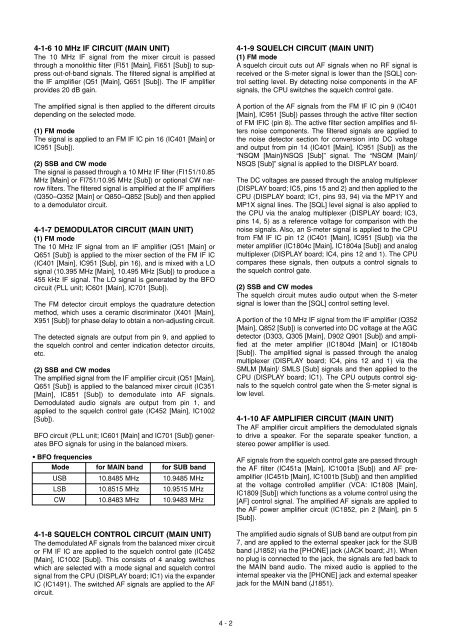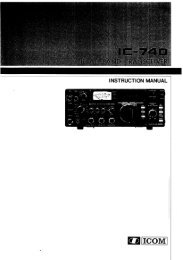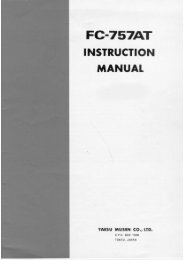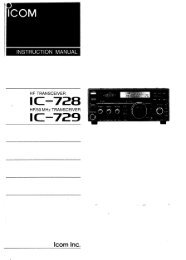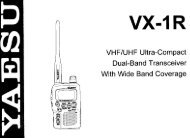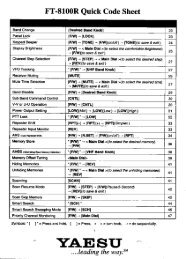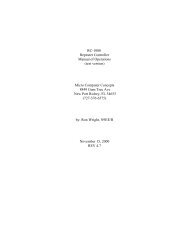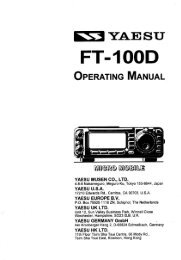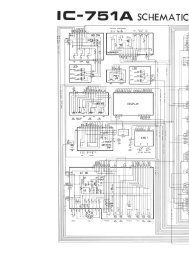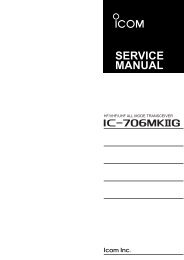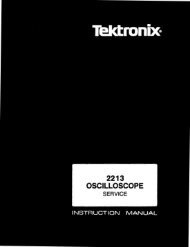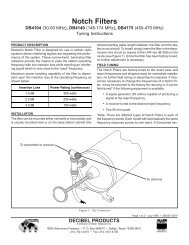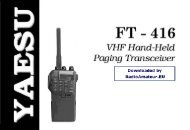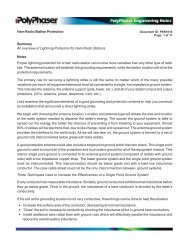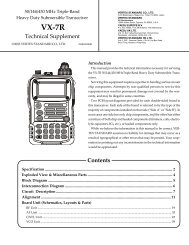You also want an ePaper? Increase the reach of your titles
YUMPU automatically turns print PDFs into web optimized ePapers that Google loves.
4-1-6 10 MHz IF CIRCUIT (MAIN UNIT)<br />
The 10 MHz IF signal from the mixer circuit is passed<br />
through a monolithic filter (Fl51 [Main], Fl651 [Sub]) to suppress<br />
out-of-band signals. The filtered signal is amplified at<br />
the IF amplifier (Q51 [Main], Q651 [Sub]). The IF amplifier<br />
provides 20 dB gain.<br />
The amplified signal is then applied to the different circuits<br />
depending on the selected mode.<br />
(1) FM mode<br />
The signal is applied to an FM IF <strong>IC</strong> pin 16 (<strong>IC</strong>401 [Main] or<br />
<strong>IC</strong>951 [Sub]).<br />
(2) SSB and CW mode<br />
The signal is passed through a 10 MHz IF filter (FI151/10.85<br />
MHz [Main] or Fl751/10.95 MHz [Sub]) or optional CW narrow<br />
filters. The filtered signal is amplified at the IF amplifiers<br />
(Q350–Q352 [Main] or Q850–Q852 [Sub]) and then applied<br />
to a demodulator circuit.<br />
4-1-7 DEMODULATOR CIRCUIT (MAIN UNIT)<br />
(1) FM mode<br />
The 10 MHz IF signal from an IF amplifier (Q51 [Main] or<br />
Q651 [Sub]) is applied to the mixer section of the FM IF <strong>IC</strong><br />
(<strong>IC</strong>401 [Main], <strong>IC</strong>951 [Sub], pin 16), and is mixed with a LO<br />
signal (10.395 MHz [Main], 10.495 MHz [Sub]) to produce a<br />
455 kHz IF signal. The LO signal is generated by the BFO<br />
circuit (PLL unit; <strong>IC</strong>601 [Main], <strong>IC</strong>701 [Sub]).<br />
The FM detector circuit employs the quadrature detection<br />
method, which uses a ceramic discriminator (X401 [Main],<br />
X951 [Sub]) for phase delay to obtain a non-adjusting circuit.<br />
The detected signals are output from pin 9, and applied to<br />
the squelch control and center indication detector circuits,<br />
etc.<br />
(2) SSB and CW modes<br />
The amplified signal from the IF amplifier circuit (Q51 [Main],<br />
Q651 [Sub]) is applied to the balanced mixer circuit (<strong>IC</strong>351<br />
[Main], <strong>IC</strong>851 [Sub]) to demodulate into AF signals.<br />
Demodulated audio signals are output from pin 1, and<br />
applied to the squelch control gate (<strong>IC</strong>452 [Main], <strong>IC</strong>1002<br />
[Sub]).<br />
BFO circuit (PLL unit; <strong>IC</strong>601 [Main] and <strong>IC</strong>701 [Sub]) generates<br />
BFO signals for using in the balanced mixers.<br />
• BFO frequencies<br />
Mode for MAIN band for SUB band<br />
USB<br />
LSB<br />
CW<br />
10.8485 MHz<br />
10.8515 MHz<br />
10.8483 MHz<br />
10.9485 MHz<br />
10.9515 MHz<br />
10.9483 MHz<br />
4-1-8 SQUELCH CONTROL CIRCUIT (MAIN UNIT)<br />
The demodulated AF signals from the balanced mixer circuit<br />
or FM IF <strong>IC</strong> are applied to the squelch control gate (<strong>IC</strong>452<br />
[Main], <strong>IC</strong>1002 [Sub]). This consists of 4 analog switches<br />
which are selected with a mode signal and squelch control<br />
signal from the CPU (DISPLAY board; <strong>IC</strong>1) via the expander<br />
<strong>IC</strong> (<strong>IC</strong>1491). The switched AF signals are applied to the AF<br />
circuit.<br />
4-1-9 SQUELCH CIRCUIT (MAIN UNIT)<br />
(1) FM mode<br />
A squelch circuit cuts out AF signals when no RF signal is<br />
received or the S-meter signal is lower than the [SQL] control<br />
setting level. By detecting noise components in the AF<br />
signals, the CPU switches the squelch control gate.<br />
A portion of the AF signals from the FM IF <strong>IC</strong> pin 9 (<strong>IC</strong>401<br />
[Main], <strong>IC</strong>951 [Sub]) passes through the active filter section<br />
of FM IF<strong>IC</strong> (pin 8). The active filter section amplifies and filters<br />
noise components. The filtered signals are applied to<br />
the noise detector section for conversion into DC voltage<br />
and output from pin 14 (<strong>IC</strong>401 [Main], <strong>IC</strong>951 [Sub]) as the<br />
“NSQM [Main]/NSQS [Sub]” signal. The “NSQM [Main]/<br />
NSQS [Sub]” signal is applied to the DISPLAY board.<br />
The DC voltages are passed through the analog multiplexer<br />
(DISPLAY board; <strong>IC</strong>5, pins 15 and 2) and then applied to the<br />
CPU (DISPLAY board; <strong>IC</strong>1, pins 93, 94) via the MP1Y and<br />
MP1X signal lines. The [SQL] level signal is also applied to<br />
the CPU via the analog multiplexer (DISPLAY board; <strong>IC</strong>3,<br />
pins 14, 5) as a reference voltage for comparison with the<br />
noise signals. Also, an S-meter signal is applied to the CPU<br />
from FM IF <strong>IC</strong> pin 12 (<strong>IC</strong>401 [Main], <strong>IC</strong>951 [Sub]) via the<br />
meter amplifier (<strong>IC</strong>1804c [Main], <strong>IC</strong>1804a [Sub]) and analog<br />
multiplexer (DISPLAY board; <strong>IC</strong>4, pins 12 and 1). The CPU<br />
compares these signals, then outputs a control signals to<br />
the squelch control gate.<br />
(2) SSB and CW modes<br />
The squelch circuit mutes audio output when the S-meter<br />
signal is lower than the [SQL] control setting level.<br />
A portion of the 10 MHz IF signal from the IF amplifier (Q352<br />
[Main], Q852 [Sub]) is converted into DC voltage at the AGC<br />
detector (D303, Q305 [Main], D902 Q901 [Sub]) and amplified<br />
at the meter amplifier (<strong>IC</strong>1804d [Main] or <strong>IC</strong>1804b<br />
[Sub]). The amplified signal is passed through the analog<br />
multiplexer (DISPLAY board; <strong>IC</strong>4, pins 12 and 1) via the<br />
SMLM [Main]/ SMLS [Sub] signals and then applied to the<br />
CPU (DISPLAY board; <strong>IC</strong>1). The CPU outputs control signals<br />
to the squelch control gate when the S-meter signal is<br />
low level.<br />
4-1-10 AF AMPLIFIER CIRCUIT (MAIN UNIT)<br />
The AF amplifier circuit amplifiers the demodulated signals<br />
to drive a speaker. For the separate speaker function, a<br />
stereo power amplifier is used.<br />
AF signals from the squelch control gate are passed through<br />
the AF filter (<strong>IC</strong>451a [Main], <strong>IC</strong>1001a [Sub]) and AF preamplifier<br />
(<strong>IC</strong>451b [Main], <strong>IC</strong>1001b [Sub]) and then amplified<br />
at the voltage controlled amplifier (VCA: <strong>IC</strong>1808 [Main],<br />
<strong>IC</strong>1809 [Sub]) which functions as a volume control using the<br />
[AF] control signal. The amplified AF signals are applied to<br />
the AF power amplifier circuit (<strong>IC</strong>1852, pin 2 [Main], pin 5<br />
[Sub]).<br />
The amplified audio signals of SUB band are output from pin<br />
7, and are applied to the external speaker jack for the SUB<br />
band (J1852) via the [PHONE] jack (JACK board; J1). When<br />
no plug is connected to the jack, the signals are fed back to<br />
the MAIN band audio. The mixed audio is applied to the<br />
internal speaker via the [PHONE] jack and external speaker<br />
jack for the MAIN band (J1851).<br />
4 - 2


